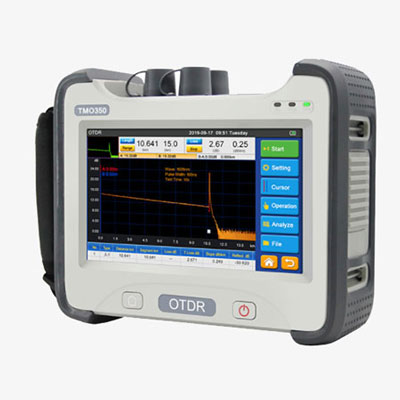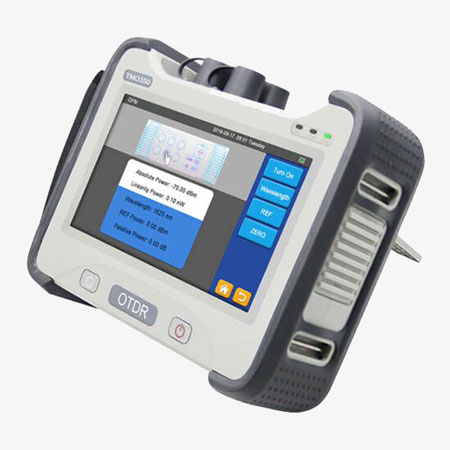5-in-1 OTDR fiber tester (OTDR, optical power meter, visual fault locator, optical light source and event map ), built-in high-power visual laser source, can accurately locate the nearest fault point, multiple measurement modes, just one button to complete the measurement. OTDR fiber tester is easy to carry and use for outdoor field operations, 7.4V/6.6Ah lithium battery large capacity to ensure ultra-long standby.

Intelligent testing, simple use, powerful function.
- Multi-measurement mode, easy to use, just one button to complete the measurement.
- Real-time measurement function, easy to monitor the splicing process.
- Optical time domain reflectometer built-in high-power visual laser source can accurately locate the closer fault points.
- 2 primary USB ports and 1 secondary USB port, can be controlled by PC or connected to external instruments.
- 5-in-1 OTDR fiber tester with built-in 8G memory. Store over 80,000 sets of curves.
- Provide data simulation software for processing, generating and printing reports.

All-in-one multi-functional OTDR fiber tester
- Measure the loss of splicing points, optical connectors, and adapters.
- Measure the loss of a single fiber or cable.
- Measure the length of the cable, and set different refractive indices for various fibers.
- Locate the position of a broken point, Optical connector, and adapter.
- Measure the discrete reflection ratio between SR points.
- Measure return loss for the whole fiber circuit including connecting points and S points.
Application
OTDR (optical time domain reflectometer) uses the backward scattered light generated when the light propagates in the fiber to obtain attenuation information, which can be used to measure fiber attenuation, splice loss, fiber fault location and understand the loss distribution along the length of the fiber, etc. OTDR tester is an essential tool in fiber optic cable construction, maintenance, and monitoring.

| Model | SISCO-TMO-350 |
| Testing Wavelength | 1310/1550nm |
| Dynamic Range | 32/30dB |
| Event Dead Zone | 0.8m |
| Attenuation Dead Zone | 4m |
| Pulse Width | 3ns, 5ns, 10ns, 20ns, 50ns, 100ns, 200ns, 500ns, 1μs, 2μs, 5μs, 10μs, 20μs |
| Testing Distance | 500m, 2km, 5km, 10km, 20km, 40km, 80km, 120km, 160km |
| Measurement Time | Use-defined (smart link) ; with real-time measurement function |
| Linearity | ≤0.05dB/Db |
| Loss Threshold | 0.01dB |
| Loss Resolution | 0.001dB |
| Distance Resolution | 0.01m |
| Sampling Resolution | Minimum 0.25m |
| Sampling Point | Maximum 128,000 points |
| Distance Accuracy | ±(1m+measuring distance×3×10-5+sampling resolution ) |
| Internal Visual Source | 10mw, CW/2Hz |
| Stable Laser Source | >-5dBm |
| Data Storage | 80000 groups of curve |
| Interface | 3 USB port |
| Display | 7 inch capacitive touching screen |
| Battery | 7.4V/6.6Ah lithium battery, continuous 8-10 hours |
| Operating Temperature | -10℃~+50℃ |
| Storage Temperature | -20℃~+75℃ |
| Relative Humidity | ≤90%, non-den |
| Dimension | 230×185×70mm/1.5kg |
| Accessories | Main unit, 8.4V power adapter, Lithium battery, FC adapter, USB cord, User guide, CD disk, carrying case |
Q1: What is an OTDR used for?
A1: OTDR is a fiber optic instrument used to characterize, troubleshoot and maintain optical communication networks. OTDR testing is performed by transmitting and analyzing pulsed laser light through an optical fiber.
Q2: What is fiber loss?
A2: Optical fiber loss is the attenuation per unit length of optical fiber in dB/km, the level of fiber loss directly affects the transmission distance or the distance between relay stations, therefore, understanding and reducing the loss of optical fiber is of great practical significance for fiber optic communication.
Q3: What is an optical time domain reflectometer?
A3: The optical time domain reflectometer is a fiber optic tester used to test the characteristics of optical communication networks. OTDR is designed to detect, locate and measure events at any location on a fiber optic link. OTDR requires access to only one end of the link and works in a manner similar to a one-dimensional radar system. By providing graphical trace characteristics of the fiber under test, the user can obtain a graphical representation of the entire fiber link.
Tips: Why is the test data of the optical time domain reflectometer unstable?
- The setting parameters of the optical time domain reflectometer are unreasonable.
- The optical time domain reflectometer's built-in fiber optic adapter is dirty or damaged.
- The optical module of the OTDR is damaged.
Thank you for buying industrial test and measurement equipment on SISCO.com, all products sold by SISCO and the partner cover a 12 months warranty, effective from the date of receiving the products.
What is covered?
SISCO is responsible for providing free spare parts, and free technical support to assist the customer to repair the defective products until the problem is solved.
What is not covered?
- Product purchased from anyone other than a SISCO store or a SISCO authorized reseller.
- Expendable parts.
- Routine cleaning or normal cosmetic and mechanical wear.
- Damage from misuse, abuse or neglect.
- Damage from use of parts other than SISCO approved.
- Damage from use outside the product’s usage or storage parameters.
- Damage from use of parts not sold by SISCO.
- Damage from modification or incorporation into other products.
- Damage from repair or replacement of warranted parts by a service provider other than a SISCO authorized service provider.
- Damage caused by the application environment not meeting the product usage requirements and the failure to perform preventive maintenance.

